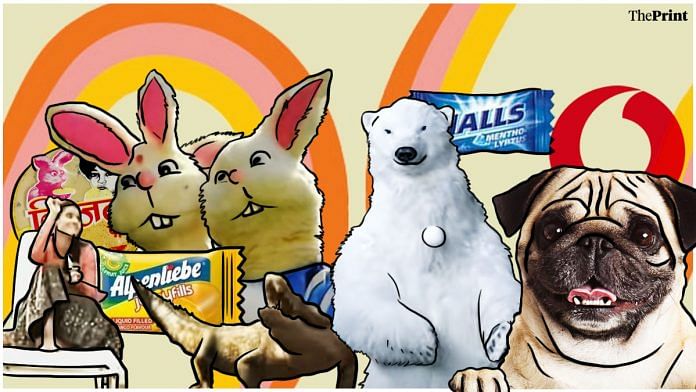New Delhi: Why do we need a rabbit to sell ‘papad’ or an arctic polar bear to promote mint candy? The answer perhaps lies in the emotional connection that people have with our furry four-legged friends that helps build brand awareness.
Nearly all of us have grown up being surrounded by quirky advertisements — some with the biggest names in Bollywood and others with catchy tunes. But the ads that have stuck out the most were, by far, the ones featuring our friends from the animal kingdom.
From dogs and cats to gorillas, the Indian advertising industry has incorporated animals to create impressionable ads that have stood the test of time.
Lijjat Papad, a women-led papad company, is a popular brand that has been around for nearly seven decades. But besides its lip-smacking papads, what the brand is most popular for is a fluffy pink muppet rabbit that adorns the plastic wrapping of its product.
In between movies and serials in the 90s, the Lijjat papad commercial would appear on TV screens with this bunny singing:
“Chai aur coffee ke sang khaye, karram kurram,
Mehmaano ko bhi khilaaye, kurram karram,
Mazedar lazzatdar swaad swaad mein lazzat Lijjat papad”
People haven’t been able to rid themselves of this bunny and its catchy jingle over the years. YouTube channels that have archived some of these old advertisements amassed a significant user following. If one were to visit these videos, she or he would be met with comments like “ahhh good old memories….gonna fry me some papads for dinner tonight” or “that rabbit made my childhood awesome”.
Also read: Raj Comics – publishers who brought home your friendly, neighbourhood desi superheroes
‘Cheeka’, the pug
Even though there was the fluffy little Lijjat rabbit and the likes of other such furry friends endorsing brands that they probably had no idea about, nothing truly captivated India like Hutch/Vodafone Idea’s ‘Cheeka’ the pug from its 2003 commercial.
The makers of Hutchinson Essar’s ‘You & I’ campaign were Rajiv Rao and Mahesh V from Ogilvy & Mather (O&M). Both Rao and Mahesh have gone on the record many times to say that there were intentionally no phones shown in the ads. A boy wanders around town with a dog at his heels — wherever you go, the network follows. It was a simple message that they’d set out to popularise.
Mallika Yamdagni, brand strategy director at Leo Burnett, told ThePrint, “The visualisation of their core benefit into an animal was genius. They were disruptors — the first in their category to do something like this — creating an ad that was simple, felt good, and was easy to understand. And Cheeka played a central role in the narrative, she wasn’t there just to window dress the ad with cuteness.”
India is a huge country that speaks over 121 languages. O&M had somehow managed to craft an ad campaign that spoke to all without the boundaries of language and overcame cultural differences. Till about 2005, Cheeka’s photo was the most popular wallpaper downloaded by Vodaphone customers. Such was the campaign’s popularity that it triggered a ‘pug mania‘ in the country, as the dog became one of the most sought-after breeds.
Cheeka and O&M also started a trend of featuring animals with human-like characteristics in advertisements, and by the late 2000s we had an arsenal of them in sugar confectionery brand Halls featuring an arctic polar bear to promote its mint candy, the crow in the Big Babol ad, and even Alpenliebe’s ad featuring a crocodile.
What worked
A lot of the decisions we make in our lives are driven by our emotions. And ad makers were able to recognise that. There are only a few things that are able to evoke powerful emotions in humans as animals do.
Siddharth Menon, a creative director based out of Gurugram, told ThePrint, “Why do cat videos go viral? Because there is a huge audience for it.”
In the Theory of Evolution, Charles Darwin says there is an innate commonality between animal species — and that extends to our relationship with animals. Human beings, research says, are predominantly visual beings and able to understand imagery better than text and also remember it.
Menon explained how ads featuring animals today are “tailor-made for online consumption — short, highly shareable, minimal dialogue, doesn’t require rapt attention and gives a nice dopamine rush”.
“An animal can help an ad stand out visually,” he added, and called them “storytelling devices” that can help capture an audience’s attention.
Animals are also able to bring people from across demographics together. Yamdagni explained, “Cuteness sells — animals, babies, what have you. It is a positive, unadulterated emotion that can universally appeal cutting across genders, demographics and social classes.”
As we saw in the cases of Cheeka and the Lijjat’s furry rabbit, people across the country remember these mascots and still associate them with their respective brands. These ads spoke to audiences beyond language, age, gender and regional differences.
Also read: From Lakshmi to Lakmé — story of India’s first cosmetic brand, envisioned by PM Nehru



